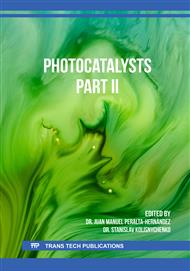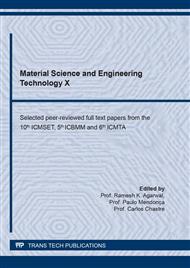[1]
M. B. Azim, I. Arafat, R. Morshed, and R. Tareq, Degradation of Methylene Blue Using Graphene Oxide-Tin Oxide Nanocomposite as Photocatalyst,, in 1st International Conference on Engineering Materials and Metallurgical Engineering, 2016, p.202–209.
Google Scholar
[2]
M. Farhan Hanafi and N. Sapawe, A review on the water problem associate with organic pollutants derived from phenol, methyl orange, and remazol brilliant blue dyes,, Mater. Today Proc., vol. 31, no. xxxx, pp. A141–A150, (2020).
DOI: 10.1016/j.matpr.2021.01.258
Google Scholar
[3]
D. A. G. Sumalinog, S. C. Capareda, and M. D. G. De Luna, Evaluation of the effectiveness and mechanisms of acetaminophen and methylene blue dye adsorption on activated biochar derived from municipal solid wastes,, J. Environ. Manage., vol. 210, p.255–262, (2018).
DOI: 10.1016/j.jenvman.2018.01.010
Google Scholar
[4]
A. Chithambararaj, B. Winston, N. S. Sanjini, S. Velmathi, and A. C. Bose, Band gap tuning of h -MoO3 nanocrystals for efficient visible light photocatalytic activity against methylene blue dye,, J. Nanosci. Nanotechnol., vol. 15, no. 7, p.4913–4919, (2015).
DOI: 10.1166/jnn.2015.9846
Google Scholar
[5]
H. Koyuncu and A. R. Kul, Removal of methylene blue dye from aqueous solution by nonliving lichen (Pseudevernia furfuracea (L.) Zopf.), as a novel biosorbent,, Appl. Water Sci., vol. 10, no. 2, p.1–14, (2020).
DOI: 10.1007/s13201-020-1156-9
Google Scholar
[6]
J. Cheng et al., Highly Efficient Removal of Methylene Blue Dye from an Aqueous Solution Using Cellulose Acetate Nanofibrous Membranes Modified by Polydopamine,, ACS Omega, vol. 5, no. 10, p.5389–5400, (2020).
DOI: 10.1021/acsomega.9b04425
Google Scholar
[7]
S. Sharma and A. Kaur, Various methods for removal of dyes from industrial effluents - a review,, Indian J. Sci. Technol., vol. 11, no. 12, p.1–21, (2018).
Google Scholar
[8]
V. Katheresan, J. Kansedo, and S. Y. Lau, Efficiency of various recent wastewater dye removal methods: A review,, J. Environ. Chem. Eng., vol. 6, no. 4, p.4676–4697, (2018).
DOI: 10.1016/j.jece.2018.06.060
Google Scholar
[9]
S. Dhanavel, E. Nivethaa, V. Narayanan, and A. Stephen, Visible Light Induced Photocatalytic Degradation of Methylene Blue using Polyaniline Modified Molybdenum Trioxide,, Mechanika, vol. 9, no. April, p.1–6, (2017).
Google Scholar
[10]
V. Subramanian, V. G. Pangarkar, and A. A. C. M. Beenackers, Photocatalytic degradation of para-hydroxybenzoic acid: Relationship between substrate adsorption and photocatalytic degradation,, Clean Prod. Process., vol. 2, no. 3, p.0149–0156, (2000).
DOI: 10.1007/s100980000080
Google Scholar
[11]
D. S. Bhatkhande, V. G. Pangarkar, and A. A. C. M. Beenackers, Photocatalytic degradation for environmental applications – a review,, J. Chem. Technol. Biotechnol., vol. 77, no. April 2001, p.102–106, (2001).
DOI: 10.1002/jctb.532
Google Scholar
[12]
A. Chithambararaj, N. S. Sanjini, S. Velmathi, and A. Chandra Bose, Preparation of h-MoO3 and α-MoO3 nanocrystals: comparative study on photocatalytic degradation of methylene blue under visible light irradiation,, Phys. Chem. Chem. Phys., (2013).
DOI: 10.1039/c3cp51796a
Google Scholar
[13]
M. B. R. Kamalam, S. S. R. Inbanathan, and K. Sethuraman, Enhanced photo catalytic activity of graphene oxide /MoO 3 nanocomposites in the degradation of Victoria Blue Dye under visible light irradiation,, Appl. Surf. Sci., vol. 449, p.685–696, (2018).
DOI: 10.1016/j.apsusc.2017.12.099
Google Scholar
[14]
Shahab-ud-Din et al., Hydrothermal synthesis of molybdenum trioxide, characterization and photocatalytic activity,, Mater. Res. Bull., vol. 100, no. November 2017, p.120–130, (2018).
DOI: 10.1016/j.materresbull.2017.11.044
Google Scholar
[15]
S. K. Fanourakis, J. Peña-Bahamonde, P. C. Bandara, and D. F. Rodrigues, Nano-based adsorbent and photocatalyst use for pharmaceutical contaminant removal during indirect potable water reuse,, npj Clean Water, vol. 3, no. 1, p.1, Jan. (2020).
DOI: 10.1038/s41545-019-0048-8
Google Scholar
[16]
M. Nikazar, M. Alizadeh, R. Lalavi, and M. H. Rostami, The optimum conditions for synthesis of Fe3O4/ZnO core/shell magnetic nanoparticles for photodegradation of phenol,, J. Environ. Heal. Sci. Eng., vol. 12, no. 1, p.1–6, (2014).
DOI: 10.1186/2052-336x-12-21
Google Scholar
[17]
K. Mondal and A. Sharma, Recent advances in the synthesis and application of photocatalytic metal-metal oxide core-shell nanoparticles for environmental remediation and their recycling process,, RSC Adv., vol. 6, no. 87, p.83589–83612, (2016).
DOI: 10.1039/c6ra18102c
Google Scholar
[18]
M. Navgire, A. Nagare, G. Kale, and S. Bhitre, Synthesis, Characterization and applications of MoO3-Fe3O4 Nanocomposite Material,, J. Met. Mater. Res., vol. 02, no. 02, p.15–20, (2019).
DOI: 10.30564/jmmr.v2i2.1124
Google Scholar
[19]
S. K. Misra, A. Dybowska, D. Berhanu, S. N. Luoma, and E. Valsami-Jones, The complexity of nanoparticle dissolution and its importance in nanotoxicological studies,, Sci. Total Environ., vol. 438, p.225–232, (2012).
DOI: 10.1016/j.scitotenv.2012.08.066
Google Scholar
[20]
J. Peña-Bahamonde, C. Wu, S. K. Fanourakis, S. M. Louie, J. Bao, and D. F. Rodrigues, Oxidation state of Mo affects dissolution and visible-light photocatalytic activity of MoO3 nanostructures,, J. Catal., vol. 381, p.508–519, (2020).
DOI: 10.1016/j.jcat.2019.11.035
Google Scholar
[21]
M. Ates, A review study of (bio)sensor systems based on conducting polymers,, Materials Science and Engineering C, vol. 33, no. 4. Elsevier B.V., p.1853–1859, (2013).
DOI: 10.1016/j.msec.2013.01.035
Google Scholar
[22]
J. Zia, J. Kashyap, and U. Riaz, Facile synthesis of polypyrrole encapsulated V2O5 nanohybrids for visible light driven green sonophotocatalytic degradation of antibiotics,, J. Mol. Liq., vol. 272, p.834–850, (2018).
DOI: 10.1016/j.molliq.2018.10.091
Google Scholar
[23]
Q. Zhou, S. Fu, M. Zou, Y. He, Y. Wu, and T. Wu, Deep oxidative desulfurization of model oil catalyzed by magnetic MoO3/Fe3O4,, RSC Adv., vol. 5, no. 85, p.69388–69393, (2015).
DOI: 10.1039/c5ra11028a
Google Scholar
[24]
X. Zhang, X. Zeng, M. Yang, and Y. Qi, Investigation of a branchlike MoO3/polypyrrole hybrid with enhanced electrochemical performance used as an electrode in supercapacitors,, ACS Appl. Mater. Interfaces, vol. 6, no. 2, p.1125–1130, (2014).
DOI: 10.1021/am404724u
Google Scholar
[25]
U. Alam, S. Kumar, D. Bahnemann, J. Koch, C. Tegenkamp, and M. Muneer, Harvesting visible light with MoO3 nanorods modified by Fe(iii) nanoclusters for effective photocatalytic degradation of organic pollutants,, Phys. Chem. Chem. Phys., vol. 20, no. 6, p.4538–4545, (2018).
DOI: 10.1039/c7cp08206a
Google Scholar
[26]
K. Kumar and A. Chowdhury, Use of Novel Nanostructured Photocatalysts for the Environmental Sustainability of Wastewater Treatments, no. i. Elsevier Ltd., (2020).
Google Scholar
[27]
S. Ahmed, M. G. Rasul, R. Brown, and M. A. Hashib, Influence of parameters on the heterogeneous photocatalytic degradation of pesticides and phenolic contaminants in wastewater: A short review,, J. Environ. Manage., vol. 92, no. 3, p.311–330, (2011).
DOI: 10.1016/j.jenvman.2010.08.028
Google Scholar
[28]
A. Chithambararaj, N. S. Sanjini, S. Velmathi, and A. Chandra Bose, Preparation of h-MoO3 and α-MoO3 nanocrystals: Comparative study on photocatalytic degradation of methylene blue under visible light irradiation,, Phys. Chem. Chem. Phys., vol. 15, no. 35, p.14761–14769, (2013).
DOI: 10.1039/c3cp51796a
Google Scholar
[29]
S. Alkaykh, A. Mbarek, and E. E. Ali-Shattle, Photocatalytic degradation of methylene blue dye in aqueous solution by MnTiO3 nanoparticles under sunlight irradiation,, Heliyon, vol. 6, no. 4, p. e03663, (2020).
DOI: 10.1016/j.heliyon.2020.e03663
Google Scholar
[30]
F. Chen et al., Enhanced Photocatalytic Degradation of Tetracycline by AgI/BiVO4 Heterojunction under Visible-Light Irradiation: Mineralization Efficiency and Mechanism,, ACS Appl. Mater. Interfaces, vol. 8, no. 48, p.32887–32900, (2016).
DOI: 10.1021/acsami.6b12278
Google Scholar
[31]
Y. Li et al., Visible-light-induced blue MoO3-C3N4 composite with enhanced photocatalytic activity,, Mater. Res. Bull., vol. 70, p.500–505, (2015).
DOI: 10.1016/j.materresbull.2015.05.013
Google Scholar
[32]
M. R. Islam, J. B. Islam, M. Furukawa, I. Tateishi, H. Katsumata, and S. Kaneco, Photocatalytic degradation of a systemic herbicide: Picloram from aqueous solution using titanium oxide (tio2) under sunlight,, ChemEngineering, vol. 4, no. 4, p.1–14, (2020).
DOI: 10.3390/chemengineering4040058
Google Scholar
[33]
Z. Hu, J. Zhou, Y. Zhang, W. Liu, J. Zhou, and W. Cai, The formation of a direct Z-scheme Bi2O3/MoO3 composite nanocatalyst with improved photocatalytic activity under visible light,, Chem. Phys. Lett., vol. 706, p.208–214, (2018).
DOI: 10.1016/j.cplett.2018.06.006
Google Scholar
[34]
W. Teng, X. Tan, X. Li, and Y. Tang, Novel Ag 3 PO 4 /MoO 3 p-n heterojunction with enhanced photocatalytic activity and stability under visible light irradiation,, Appl. Surf. Sci., vol. 409, p.250–260, (2017).
DOI: 10.1016/j.apsusc.2017.03.025
Google Scholar



